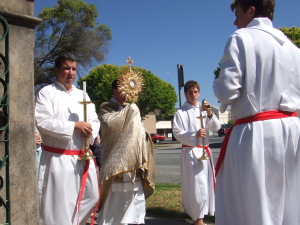“The Catholic Church has always offered and still offers to the sacrament of the Eucharist the cult of adoration, not only during the Mass, but also outside of it, reserving the consecrated hosts with the utmost care, exposing them to the solemn veneration of the faithful, and carrying them in procession.”’ CCC 1378
The Eucharist has always been considered by the Catholic Church as the ‘source and summit of the Christian life’ (CCC 1324). However after the Second Vatican Council, held from 1963-5, a number of myths regarding the Eucharist surfaced.
The most alarming of these myths is the notion that the Second Vatican Council downplayed the importance of the Eucharist in the Christian life and did away with the practise of Eucharistic Adoration. Further to this, the myth also claimed that those who continue to venerate the Lord in the Blessed Sacrament are trying to reverse all the good undertaken by the Second Vatican Council and change the practises of our faith to the way they were before 1963.
It is unfortunate that these claims have arisen, and more unfortunate that they are often made by detractors who have not actually read the documents from the council. To start simply, the Second Vatican Council did not abolish the practise of Eucharistic Adoration, nor does anyone who takes time to venerate our Lord in the Blessed Sacrament necessarily want to revert the Church back to the pre Vatican II era.
In the previous posts such as Part 3 of the Sacraments series and the REAL presence, we discussed that Jesus Christ is wholly, really and substantially present in the Blessed Sacrament, thus it is natural that if we want to have and maintain a relationship with Jesus, that we spend time with him. He is the one we should turn to for guidance and support. ‘In the house of prayer the most Holy Eucharist is celebrated and preserved. There the faithful gather, and find help and comfort through venerating the presence of the Son of God our Saviour, offered for us on the sacrificial altar.’ (Priests, The Documents of Vatican II)
And so we find, in the Catechism of the Catholic Church, compiled after the Second Vatican Council, that: ‘In the liturgy of the Mass we express our faith in the real presence of Christ under the species of bread and wine by, among other ways, genuflecting or bowing deeply as a sign of adoration of the Lord. “The Catholic Church has always offered and still offers to the sacrament of the Eucharist the cult of adoration, not only during the Mass, but also outside of it, reserving the consecrated hosts with the utmost care, exposing them to the solemn veneration of the faithful, and carrying them in procession.”’ (CCC 1378)
So then, what exactly is adoration? Adoration is the practise of worshipping the Blessed Sacrament (Christ). The Eucharist, reserved in the tabernacle for veneration, is removed by a priest or deacon and placed into a monstrance. The monstrance is a special vessel for holding and protecting the Blessed Sacrament during adoration. The Eucharist is clearly visible in the monstrance and those present remain in silence, praying and conversing privately with our Lord.
In addition to regular sacramental participation, adoration immerses us ever deeper into the mystery of the Eucharist – indeed the Catholic faith – strengthening our faith in, and relationship with, Jesus Christ and in turn we grow in holiness. Adoration then, is not something to be feared. It is a special time of private veneration and meditation with our Lord Jesus Christ. Indeed, if we truly believe that Jesus Christ is present in the Eucharist, then how can we pass up the opportunity to spend time with him?
First published in In Sight Magazine
Originally posted 2014-11-03 22:42:04.

